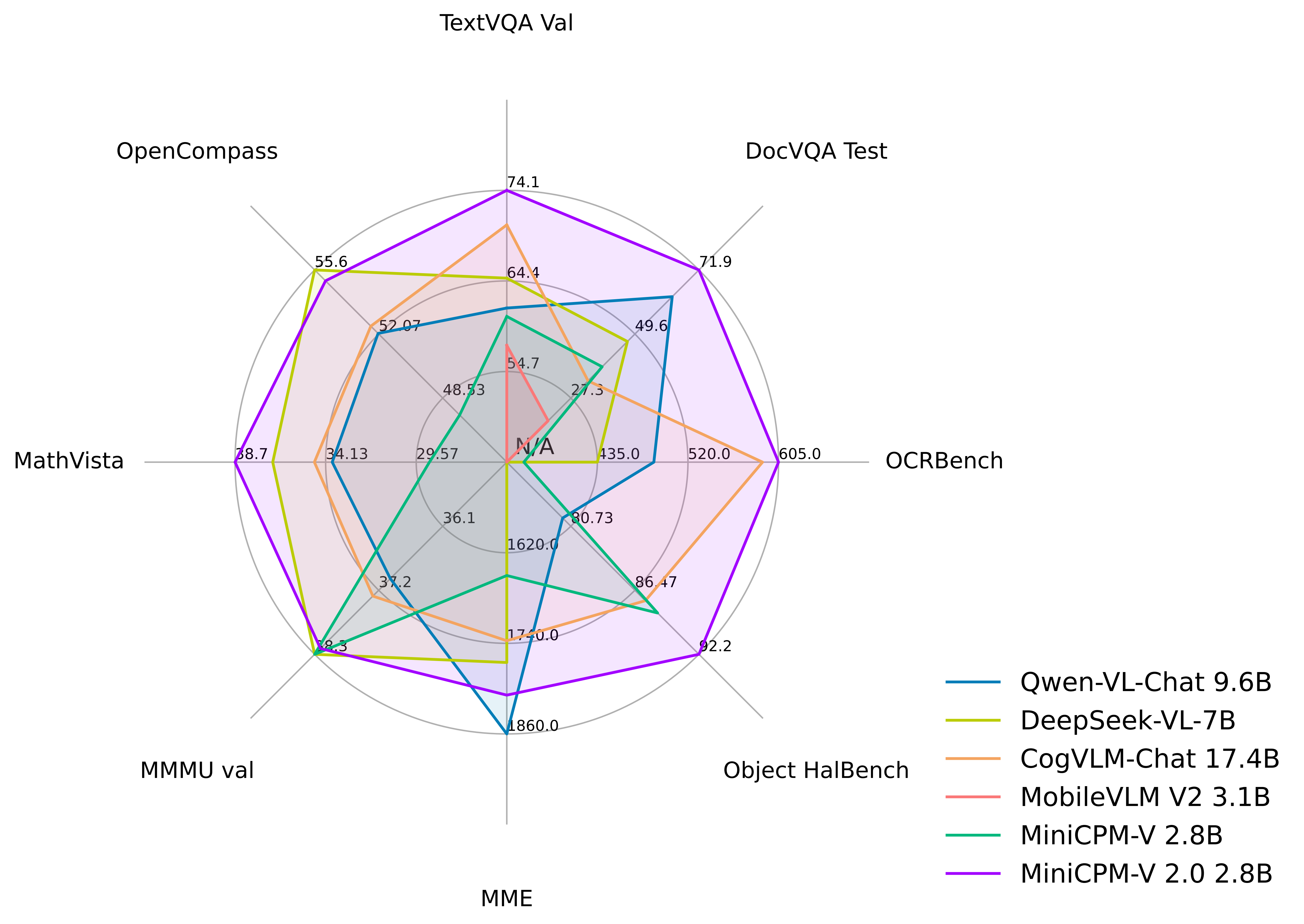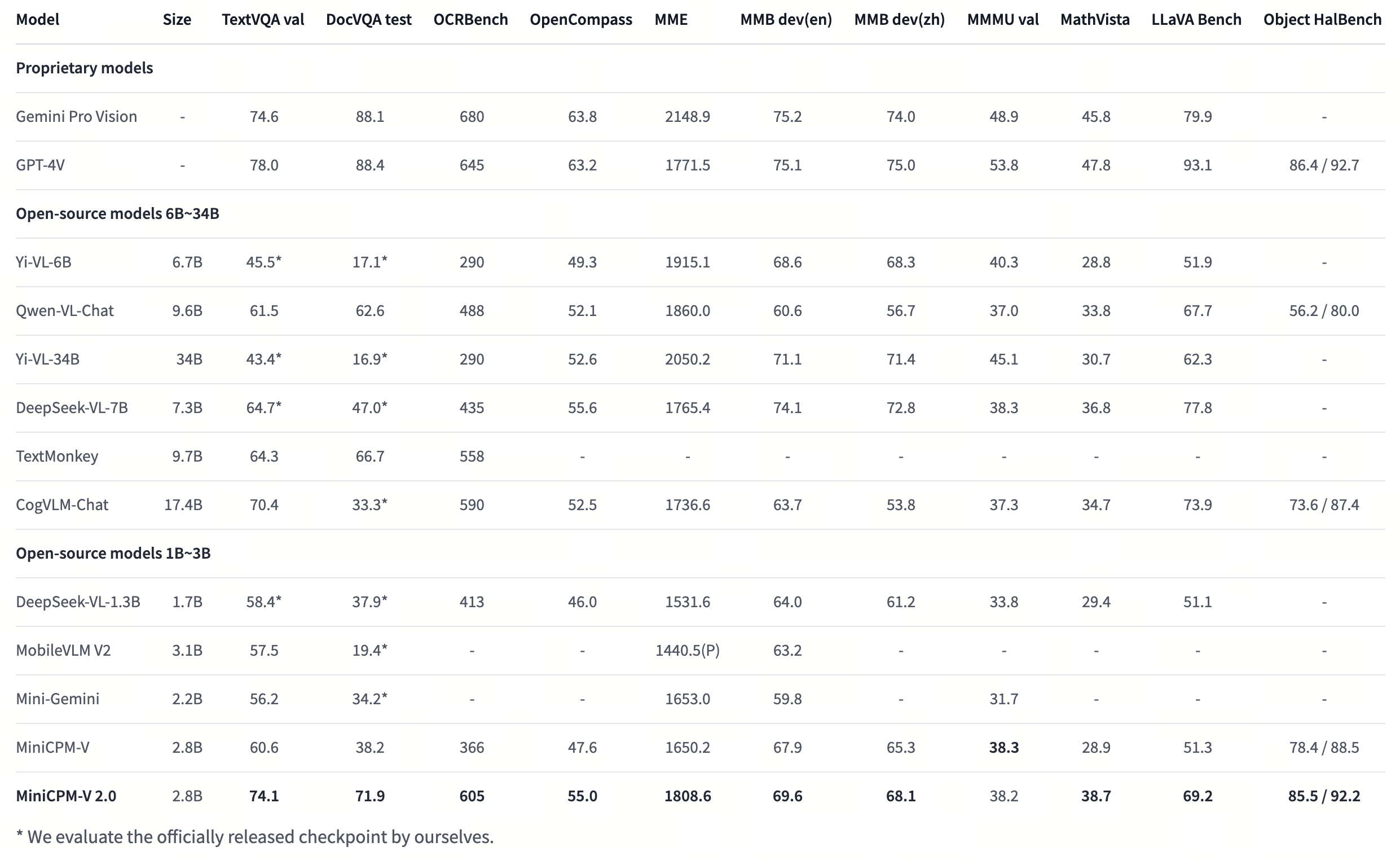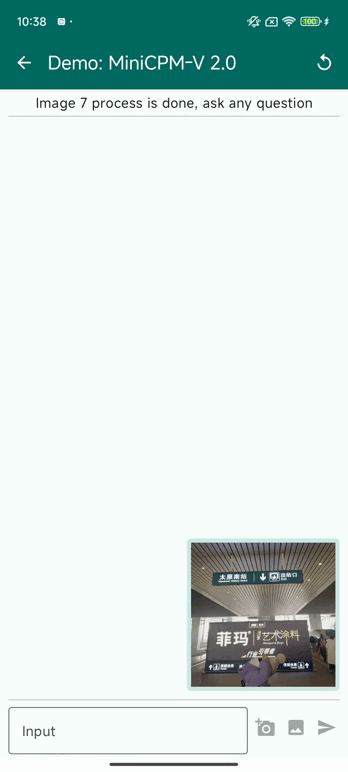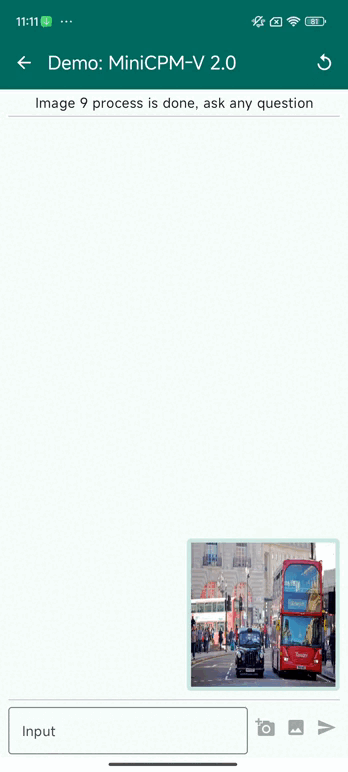News
- [2024.04.23] MiniCPM-V 2.0 supports vLLM now!
- [2024.04.18] We create a HuggingFace Space to host the demo of MiniCPM-V 2.0 at here!
- [2024.04.17] MiniCPM-V 2.0 supports deploying WebUI Demo now!
- [2024.04.15] MiniCPM-V 2.0 supports fine-tuning with the SWIFT framework!
- [2024.04.12] We open-source MiniCPM-V-2.0, which achieves comparable performance with Gemini Pro in understanding scene text and outperforms strong Qwen-VL-Chat 9.6B and Yi-VL 34B on OpenCompass, a comprehensive evaluation over 11 popular benchmarks. Click here to view the MiniCPM-V 2.0 technical blog.
MiniCPM-V 2.0
MiniCPM-V 2.8B is a strong multimodal large language model for efficient end-side deployment. The model is built based on SigLip-400M and MiniCPM-2.4B, connected by a perceiver resampler. Our latest version, MiniCPM-V 2.0 has several notable features.
🔥 State-of-the-art Performance.
MiniCPM-V 2.0 achieves state-of-the-art performance on multiple benchmarks (including OCRBench, TextVQA, MME, MMB, MathVista, etc) among models under 7B parameters. It even outperforms strong Qwen-VL-Chat 9.6B, CogVLM-Chat 17.4B, and Yi-VL 34B on OpenCompass, a comprehensive evaluation over 11 popular benchmarks. Notably, MiniCPM-V 2.0 shows strong OCR capability, achieving comparable performance to Gemini Pro in scene-text understanding, and state-of-the-art performance on OCRBench among open-source models.
🏆 Trustworthy Behavior.
LMMs are known for suffering from hallucination, often generating text not factually grounded in images. MiniCPM-V 2.0 is the first end-side LMM aligned via multimodal RLHF for trustworthy behavior (using the recent RLHF-V [CVPR'24] series technique). This allows the model to match GPT-4V in preventing hallucinations on Object HalBench.
🌟 High-Resolution Images at Any Aspect Raito.
MiniCPM-V 2.0 can accept 1.8 million pixels (e.g., 1344x1344) images at any aspect ratio. This enables better perception of fine-grained visual information such as small objects and optical characters, which is achieved via a recent technique from LLaVA-UHD.
⚡️ High Efficiency.
MiniCPM-V 2.0 can be efficiently deployed on most GPU cards and personal computers, and even on end devices such as mobile phones. For visual encoding, we compress the image representations into much fewer tokens via a perceiver resampler. This allows MiniCPM-V 2.0 to operate with favorable memory cost and speed during inference even when dealing with high-resolution images.
🙌 Bilingual Support.
MiniCPM-V 2.0 supports strong bilingual multimodal capabilities in both English and Chinese. This is enabled by generalizing multimodal capabilities across languages, a technique from VisCPM [ICLR'24].
Evaluation


Examples

We deploy MiniCPM-V 2.0 on end devices. The demo video is the raw screen recording on a Xiaomi 14 Pro without edition.


Demo
Click here to try out the Demo of MiniCPM-V 2.0.
Deployment on Mobile Phone
MiniCPM-V 2.0 can be deployed on mobile phones with Android and Harmony operating systems. 🚀 Try it out here.
Inference with vLLM
Click to see how to inference with vLLM
Because our pull request to vLLM is still waiting for reviewing, we fork this repository to build and test our vLLM demo. Here are the steps:- Clone our version of vLLM:
git clone https://github.com/OpenBMB/vllm.git
- Install vLLM:
cd vllm
pip install -e .
- Install timm:
pip install timm=0.9.10
- Run our demo:
python examples/minicpmv_example.py
Usage
Inference using Huggingface transformers on Nivdia GPUs or Mac with MPS (Apple silicon or AMD GPUs). Requirements tested on python 3.10:
Pillow==10.1.0
timm==0.9.10
torch==2.1.2
torchvision==0.16.2
transformers==4.36.0
sentencepiece==0.1.99
# test.py
import torch
from PIL import Image
from transformers import AutoModel, AutoTokenizer
model = AutoModel.from_pretrained('openbmb/MiniCPM-V-2', trust_remote_code=True, torch_dtype=torch.bfloat16)
# For Nvidia GPUs support BF16 (like A100, H100, RTX3090)
model = model.to(device='cuda', dtype=torch.bfloat16)
# For Nvidia GPUs do NOT support BF16 (like V100, T4, RTX2080)
#model = model.to(device='cuda', dtype=torch.float16)
# For Mac with MPS (Apple silicon or AMD GPUs).
# Run with `PYTORCH_ENABLE_MPS_FALLBACK=1 python test.py`
#model = model.to(device='mps', dtype=torch.float16)
tokenizer = AutoTokenizer.from_pretrained('openbmb/MiniCPM-V-2', trust_remote_code=True)
model.eval()
image = Image.open('xx.jpg').convert('RGB')
question = 'What is in the image?'
msgs = [{'role': 'user', 'content': question}]
res, context, _ = model.chat(
image=image,
msgs=msgs,
context=None,
tokenizer=tokenizer,
sampling=True,
temperature=0.7
)
print(res)
Please look at GitHub for more detail about usage.
MiniCPM-V 1.0
Please see the info about MiniCPM-V 1.0 here.
License
Model License
- The code in this repo is released according to Apache-2.0
- The usage of MiniCPM-V 2.0's parameters is subject to "General Model License Agreement - Source Notes - Publicity Restrictions - Commercial License"
- The parameters are fully open to acedemic research
- Please contact cpm@modelbest.cn to obtain a written authorization for commercial uses. Free commercial use is also allowed after registration.
Statement
- As a LLM, MiniCPM-V 2.0 generates contents by learning a large mount of texts, but it cannot comprehend, express personal opinions or make value judgement. Anything generated by MiniCPM-V 2.0 does not represent the views and positions of the model developers
- We will not be liable for any problems arising from the use of the MinCPM-V open Source model, including but not limited to data security issues, risk of public opinion, or any risks and problems arising from the misdirection, misuse, dissemination or misuse of the model.
Other Multimodal Projects from Our Team
Citation
If you find our work helpful, please consider citing the following papers
@article{yu2023rlhf,
title={Rlhf-v: Towards trustworthy mllms via behavior alignment from fine-grained correctional human feedback},
author={Yu, Tianyu and Yao, Yuan and Zhang, Haoye and He, Taiwen and Han, Yifeng and Cui, Ganqu and Hu, Jinyi and Liu, Zhiyuan and Zheng, Hai-Tao and Sun, Maosong and others},
journal={arXiv preprint arXiv:2312.00849},
year={2023}
}
@article{viscpm,
title={Large Multilingual Models Pivot Zero-Shot Multimodal Learning across Languages},
author={Jinyi Hu and Yuan Yao and Chongyi Wang and Shan Wang and Yinxu Pan and Qianyu Chen and Tianyu Yu and Hanghao Wu and Yue Zhao and Haoye Zhang and Xu Han and Yankai Lin and Jiao Xue and Dahai Li and Zhiyuan Liu and Maosong Sun},
journal={arXiv preprint arXiv:2308.12038},
year={2023}
}
@article{xu2024llava-uhd,
title={{LLaVA-UHD}: an LMM Perceiving Any Aspect Ratio and High-Resolution Images},
author={Xu, Ruyi and Yao, Yuan and Guo, Zonghao and Cui, Junbo and Ni, Zanlin and Ge, Chunjiang and Chua, Tat-Seng and Liu, Zhiyuan and Huang, Gao},
journal={arXiv preprint arXiv:2403.11703},
year={2024}
}
- Downloads last month
- 7,674